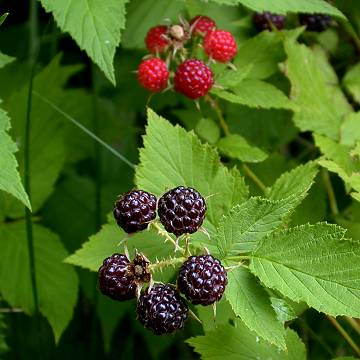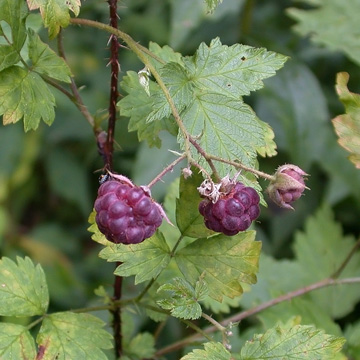

Rubus occidentalis - (image 1 of 3)
Taxonomy
Family: Rosaceae
Habitat
Common along fencerows, roadsides, edges of woods and bluffs.
Associates
Distribution
Eastern Canada and New England, south to GA, west to the Dakotas and south to OK.
Morphology
Woody perennial. Stems erect or arching, glaucous the first year, with stout straight or hooked prickles with an expanded base, the stems sometimes rooting at the tip. Leaves pinnately compound; leaflets usually 3 but sometimes 5, gray-tomentose beneath, the upper deeply serrate. Flowers white, 3-7 in an umbelliform cyme. Fruit red turning to black when ripe, occasionally yellow, with white tomentum between the drupelets, separating from the receptacle at maturity.
Notes
Flowers early May to late June
Wetland indicator: Upland
One of the best wild fruits. The berries are rather tart fresh but with a little added sugar can be used in any recipe that calls for raspberries or blackberries. The best time to pick them is usually early July. Hybrids with R. idaeus are called R. × neglectus Peck.

Purple Wild Raspberry (R. × neglectus)
References
Gleason, Henry A. and A. Cronquist. 1991. Manual of Vascular Plants of Northeastern United States and Adjacent Canada. Second Ed.
The New York Botanical Garden. Bronx, NY
Swink, F. and G. Wilhelm. 1994. Plants of the Chicago Region.
Indiana Academy of Science. The Morton Arboretum. Lisle, Illinois.
USDA, NRCS. 2002. The PLANTS Database, Version 3.5 (http://plants.usda.gov).
National Plant Data Center, Baton Rouge, LA 70874-4490 USA.
|
Michael Hough © 2005 |